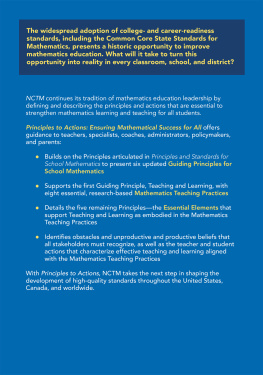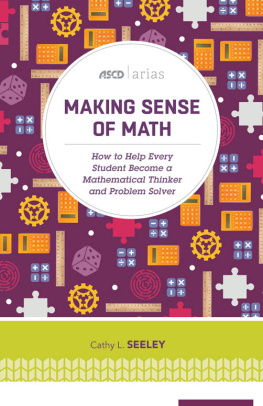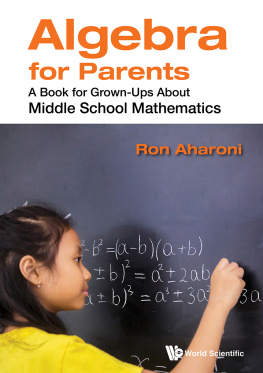Sommaire
Pagination de l'dition papier
Guide
Copyright 2014 by
The National Council of Teachers of Mathematics, Inc.
1906 Association Drive, Reston, VA 20191-1502
(703) 620-9840; (800) 235-7566; www.nctm.org
All rights reserved
ISBN 978-0-87353-904-3
The National Council of Teachers of Mathematics is the public voice of mathematics education, supporting teachers to ensure equitable mathematics learning of the highest quality for all students through vision, leadership, professional development, and research.
Principles to Actions: Ensuring Mathematical Success for All is an official position of the National Council of Teachers of Mathematics as approved by the NCTM Board of Directors, February 2014.
When forms, problems, or sample documents are included or are made available on NCTMs website, their use is authorized for educational purposes by educators and noncommercial or nonprofit entities that have purchased this book. Except for that use, permission to photocopy or use material electronically from Principles to Actions: Ensuring Mathematical Success for All must be obtained from www.copyright.com or by contacting Copyright Clearance Center, Inc. (CCC), 222 Rosewood Drive, Danvers, MA 01923, 978-750-8400. CCC is a not-for-profit organization that provides licenses and registration for a variety of users. Permission does not automatically extend to any items identified as reprinted by permission of other publishers or copyright holders. Such items must be excluded unless separate permissions are obtained. It is the responsibility of the user to identify such materials and obtain the permissions.
Principles to Actions
Writing Team
Steven Leinwand | American Institutes for Research Washington, D.C. |
Daniel J. Brahier | Bowling Green State University Bowling Green, Ohio |
DeAnn Huinker | University of WisconsinMilwaukee Milwaukee, Wisconsin |
Robert Q. Berry III | University of Virginia Charlottesville, Virginia |
Frederick L. Dillon | Strongsville City Schools (retired) Strongsville, Ohio |
Matthew R. Larson | Lincoln Public Schools Lincoln, Nebraska |
Miriam A. Leiva | University of North Carolina at Charlotte Charlotte, North Carolina |
W. Gary Martin | Auburn University Auburn, Alabama |
Margaret S. Smith | University of Pittsburgh Pittsburgh, Pennsylvania |
NCTM Board of Directors
Linda M. Gojak, President | John Carroll University University Heights, Ohio |
Diane J. Briars, President-Elect | Pittsburgh, Pennsylvania |
Bob Doucette, Executive Director | Reston, Virginia |
Robert Q. Berry III | University of Virginia Charlottesville, Virginia |
Margaret (Peg) Cagle | Vanderbilt University Nashville, Tennessee |
Dane R. Camp | Iolani School Honolulu, Hawaii |
Mark W. Ellis | California State University, Fullerton Fullerton, California |
Florence Glanfield | University of Alberta Edmonton, Alberta, Canada |
Karen J. Graham | University of New Hampshire Durham, New Hampshire |
Gladis Kersaint | University of South Florida Tampa, Florida |
Latrenda Knighten | Polk Elementary School Baton Rouge, Louisiana |
Ruth Harbin Miles | Falmouth Elementary School Mary Baldwin College Madison, Virginia |
Jane Porath | Traverse City Area Public Schools Traverse City, Michigan |
Jonathan (Jon) Wray | Howard County Public Schools Ellicott City, Maryland |
Rose Mary Zbiek | The Pennsylvania State University University Park, Pennsylvania |
Preface
The National Council of Teachers of Mathematics is proud to be the organization that launched the education standards movement. Growing out of its visionary Agenda for Action in 1980, NCTMs 1989 publication of Curriculum and Evaluation Standards for School Mathematics presented a comprehensive vision for mathematics teaching, learning, and assessment in kindergartengrade 4, grades 58, and grades 912. In 2000, NCTMs Principles and Standards for School Mathematics expanded on the 1989 Standards and added underlying Principles for school mathematics for four grade bands: pre-Kgrade 2, grades 35, grades 68, and grades 912. In 2006, Curriculum Focal Points for Prekindergarten through Grade 8 Mathematics: A Quest for Coherence extended this work by identifying the most significant mathematical concepts and skills at each level from prekindergarten through grade 8. NCTM addressed high school mathematics education in 2009 in Focus in High School Mathematics: Reasoning and Sense Making.
The next phase in the evolution of mathematics standards was the development of the Common Core State Standards for Mathematics by the National Governors Association and the Council of Chief State School Officers. The release of these standards in 2010, and their adoption by forty-five states, has presented a historic opportunity for mathematics education in the United States.
Over the past twenty-five years, we have learned that standards alone-no matter their origins, authorship, or the process by which they are developedwill not realize the goal of high levels of mathematical understanding by all students. More is needed than standards. For that reason, NCTM has developed Principles to Actions: Ensuring Mathematical Success for All, the next in its line of landmark publications guiding mathematics education into the future. Principles to Actions describes the conditions, structures, and policies that must exist for all students to learn. It addresses the essential elements of teaching and learning, access and equity, curriculum, tools and technology, assessment, and professionalism. Finally, it suggests specific actions that teachers and stakeholders need to take to realize our shared goal of ensuring mathematical success for all.
Principles to Actions represents a significant step in articulating a unified vision of what is needed to realize the potential of educating all studentsunder any standards or in any educational setting. Most important, it describes the actions required to ensure that all students learn to become mathematical thinkers and are prepared for any academic career or professional path that they choose. Principles to Actions is for teachers, coaches, specialists, principals, and other school leaders. It is for policymakers and leaders in districts and states, including commissioners, superintendents, and other central office administrators. Moreover, it will give families guidance about what to look for and expect in the system educating their children.








